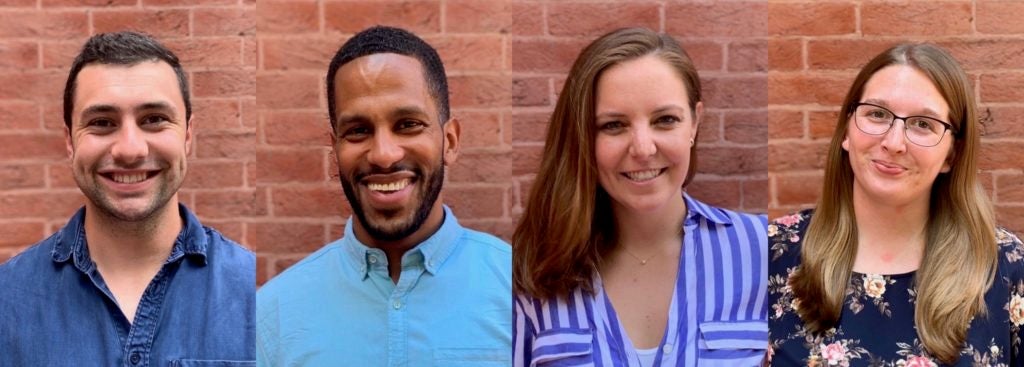Pivot Partners with McCourt Student Research Team
Posted in News
This past year, the Pivot Program partnered with a graduate student research and consulting team within The McCourt School of Public Policy in order to develop a robust way to measure the degree to which Pivot Fellows were achieving productive reentry.
Partnership Background
The McCourt School’s Master of Public Policy (MPP) degree program requires students in their final year to complete either an individual thesis or a client-based policy analysis capstone project. Led by a McCourt faculty member, students in client-based capstones work with clients over the academic year to analyze an area of importance to the client. The project culminates at the end of the Spring semester with a written research report and oral presentation summarizing the group’s findings and recommendations.
In the preceding summer, students who sign up for the capstone project are sent a list of potential clients. They then rank their interest in working on those projects.

Steven Swann (MPP’20) has been working in Washington, D.C. for the past four years in the poverty space. He had the opportunity to work quite a few times with returning citizens, which was one of the reasons why he ranked working with the Pivot Program as his first choice.
“I feel really fortunate that I was placed on this project because it was something that I had some native interest in, and I feel really fortunate that I was placed with a really sharp group of people,” said Swann.
Jessica Sattler (MPP’20), who also listed the Pivot Program as her first choice, said that the ranking system helped place students in projects that they were interested in and passionate about.
“We were a varied group of people with different skills and different backgrounds,” said Sattler. “We were able to use our skills to our own advantages within our project and help meld them together and make the project super successful.”
Developing Research Questions and Goals
Sattler, Swann, Justin Kasian (MPP’20), and Natasha Leonard (MPP’20) began working with the Pivot Program in Fall 2019. Pivot employed the capstone team to help define success for the program, to determine how to measure program outcomes, and to design a plan for future data collection and analysis.
“We were definitely inspired by reading through those goals and thinking about as a team how to translate those goals into measurable research questions to guide our project along,” said Sattler.
The team spent the remainder of the Fall semester conducting a thorough literature review, learning about similar reentry, employment, and entrepreneurship programs and studying different information in the field on how recidivism is measured.
During the Spring semester, the team began developing an evaluation framework that Pivot could use to improve its data collection processes to be able to analyze the success of the program and of Pivot Fellows going forward.
Findings and Conclusions
The team ultimately designed a 3-Tier Evaluation Model by modifying the Kirkpatrick Model of Evaluation, a widely used paradigm for program evaluation, to fit Pivot’s design and goals.
The tiered system is based off of a time horizon. Tier 1 (Immediate Level Evaluation) recommends measurements that can be implemented in the present, including gathering background information about Pivot Fellows and course evaluations. Tier 2 (Post-Program Level Evaluation) outlines measurements to evaluate Pivot Fellow progress upon graduation from the program. Tier 3 (Long-Term Evaluation) evaluates fellow outcomes years beyond program completion.
The team’s recommendations were oriented toward guiding program adjustments in the near term, as well as providing ideas to keep in mind for long term program evolution.
“We were thinking about the conditions it might take to get Pivot to its highest level of operation,” said Swann.
“The first two tiers of the plan are intended to be implemented really right away with not a lot of resources and their focus is on the short and near term, so that the people that are in the program right now and in the coming years will benefit,” said faculty advisor Micah Jensen.
However, the third tier involves more in-depth analysis and requires a robust data set, which Pivot, only in its second year, does not yet have.
Student Takeaways
The McCourt capstone configuration allows students to develop quantitative and analytical skills while working with real-world clients.
“It’s really the students that do all of the work,” said Professor Jensen. “They drive the project. They manage all the communications with the clients.”
The students agreed that the partnership between Pivot and McCourt provided a great hands-on learning experience.
Sattler said she enjoyed being able to study themes of recidivism and reincarceration in greater detail. “It was a great opportunity to be able to have this partnership with Pivot and work through this project and be able to have that experience before graduating.”
Another key takeaway from the project was the really high priority on communication and the importance of ensuring that a consultant and a client are on the same page, Swann added.
“For me it was a really good experience in the nuts and bolts of client work and what it takes to move from ideas to actual products and sort of wrestling with all the different kinds of constraints that can come up,” said Swann. “You have to be really thoughtful of what values get elevated in the choices that you’re making.”
